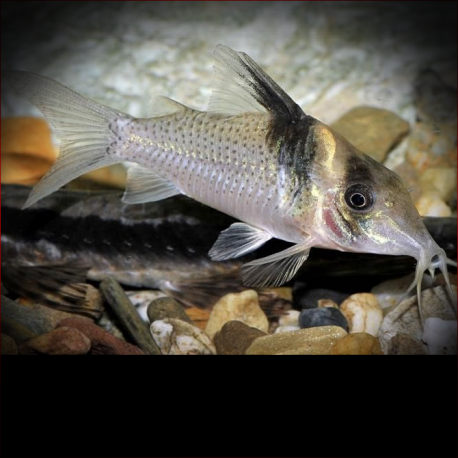More info
Datasheet
| Maximum Size | 6.0cm / 2.36inches |
| Temperature | 20°C / 68.00°F - 25°C / 77.00°F |
| Hardness | 2.02dgH / 36ppm - 15.02dgH / 268ppm |
| pH | 6.0-7.5 |
General Description
The Corydoras Ephippifer, also known as the Saddle Cory, belongs to the Callichthyidae family under the classification order Siluriformes. These fish are considered to be part of the "armoured" or "mailed" catfish group due to the presence of bony plates on their bodies. They possess a modified intestine that aids in breathing air, enabling them to survive in oxygen-deprived environments. The fish are facultative air breathers and may occasionally be observed rising to the surface to gulp air.
Aquarium Setup
To set up an aquarium for Corydoras Ephippifer, it is recommended to use a substrate of fine sand or rounded gravel that must be kept meticulously clean. Other decorations are optional, but it is advised to provide some cover for the fish to feel secure. Water conditions for the tank should be maintained with a hardness of 36-268ppm, a pH range of 6.0-7.5, and a temperature between 20-25°C (see table for details).
Behaviour
The Saddle Cory is known to exhibit peaceful and gregarious behavior and should ideally be kept in a group of at least 4-6 individuals for their well-being. However, handling these fish should be done with care as their stiffened pectoral-fin spines can cause painful stings. It is believed that the axillary gland secretions at the base of these spines may have mild toxic or venomous properties.
Feeding and Diet
Corydoras Ephippifer are foraging omnivores that accept a variety of sinking dried foods, along with small live and frozen options like bloodworms and Tubifex. Maintaining a diverse diet ensures the fish remain in optimal condition. It is crucial not to rely on leftovers from other fish in the tank for the Saddle Cory's sustenance or expect them to clean the aquarium.
Reproduction & Dimorphism
In terms of sexual dimorphism, females of Corydoras Ephippifer tend to grow larger and appear rounder and higher-bodied than males when sexually mature. However, more precise diagnostic characteristics for distinguishing this species are currently unavailable due to limited information since its original publication. The etymology of the species name stems from the Latin and Greek words referring to the distinctive saddle-like marking on the fish's upper body.
Habitat and Distribution
Native to the state of Amapá in northeastern Brazil, the specific distribution details and habitat observations of Corydoras Ephippifer are scarce. The type locality for these fish is the Cachoera Creek at the right bank of Rio Amapari, located 4 kilometers downstream from Casa do 7 in Amapá State, Brazil.

